Pompeii, the ancient Roman city frozen in time, offers a captivating glimpse into the past. A private two-hour walking tour allows visitors to enjoy the well-preserved ruins and uncover the daily lives of Pompeii’s inhabitants. From the iconic forum to the haunting human casts, this tailored experience promises an educational and insightful journey. Skilled local experts guide participants through the city’s highlights, sharing their knowledge and insights to bring Pompeii’s captivating history to life. As you wander the ancient streets, you’ll be left wondering about the untold stories that still linger within these timeless walls.
Key Points
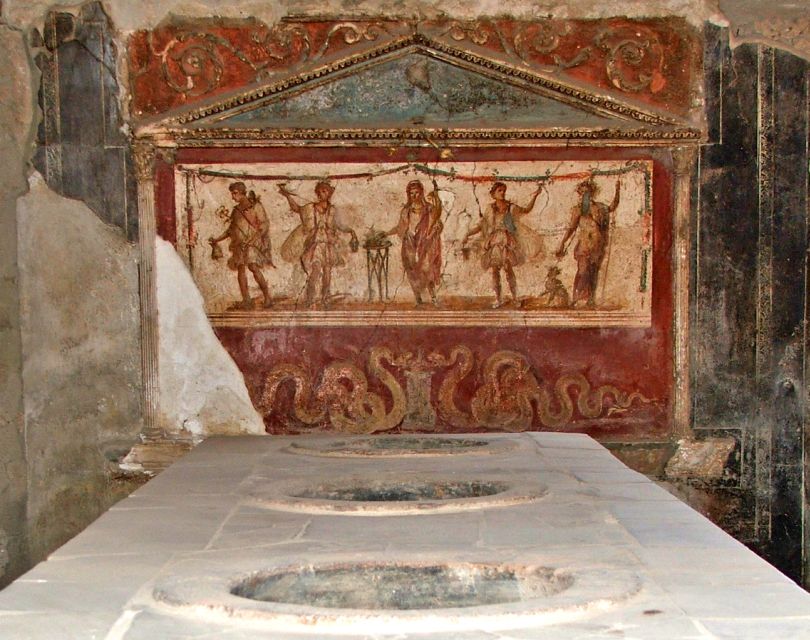
- Explore the well-preserved ruins of ancient Pompeii, including the iconic Porta Marina city gate, the Forum, and the haunting human casts.
- Gain insights into the daily life and culture of Pompeii through a tailored, private 2-hour walking tour with skilled guides.
- Discover the captivating frescoes, bakeries, and other well-preserved artifacts that provide a glimpse into the vibrant social and economic fabric of the ancient city.
- Witness the impressive scale and artistry of Pompeii’s urban planning, including the city’s sophisticated commercial and administrative center, the Forum.
- Enjoy the history and tragedy of Pompeii’s demise, as you witness the poignant reminders of the victims’ final moments during the 79 AD volcanic eruption.
Tour Description
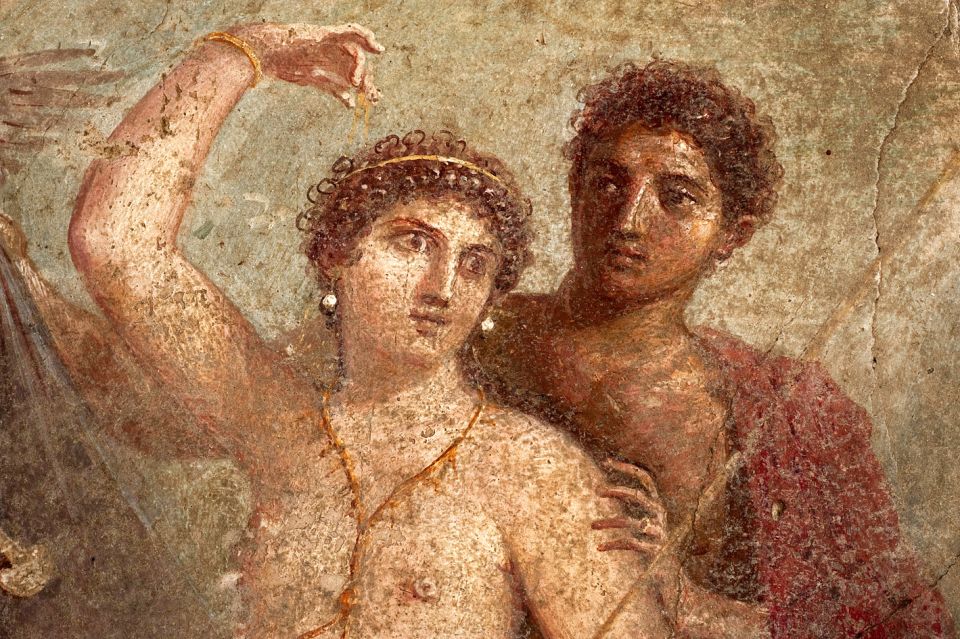
The Pompeii Walking Tour offers visitors a unique opportunity to explore the ancient Roman town frozen in time by the catastrophic 79 AD volcanic eruption.
This private 2-hour walking tour provides a tailored experience, allowing guests to enjoy the ruins at their own pace and focus on the areas that most interest them.
Skilled guides lead the way, sharing insights into the well-preserved city gates, the original volcanic basalt road, and the iconic forum, which housed temples, markets, and other important structures.
From the haunting human casts to the remarkably preserved bakeries and the intriguing frescoes of the Red Light District, this tour offers a captivating glimpse into life in ancient Pompeii.
You can also read our reviews of more walking tours in Pompei
Sights to Explore
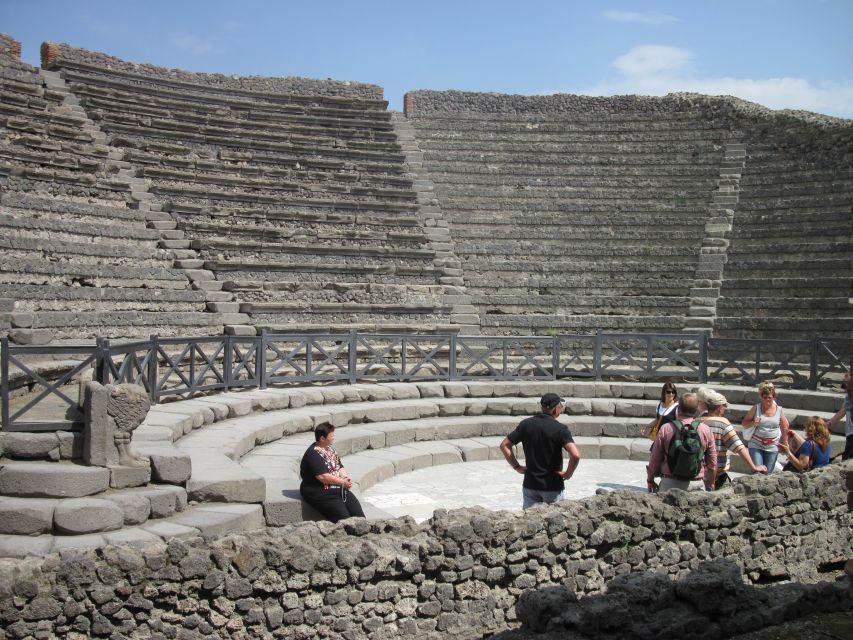
Pompeii’s Porta Marina, the well-preserved city gate, offers a captivating introduction to the ancient town’s architecture and history. Visitors can stroll along the original Via Basalt, a road made of volcanic basalt rock that transported residents through the bustling urban center.
The iconic Forum, the heart of Pompeii, housed important buildings like the Temple of Apollo and the Macellum market.
Haunting human casts reveal the final moments of Pompeii’s residents, frozen in time by the 79 AD volcanic eruption. Visitors can also explore the remains of ancient bakeries, where carbonized loaves of bread were discovered, and the intriguing ‘Red Light District‘ with its frescoes of erotic images.
Pompeii’s theaters, both outdoor and indoor, offer a glimpse into the entertainment and cultural life of the ancient Roman city.
Porta Marina
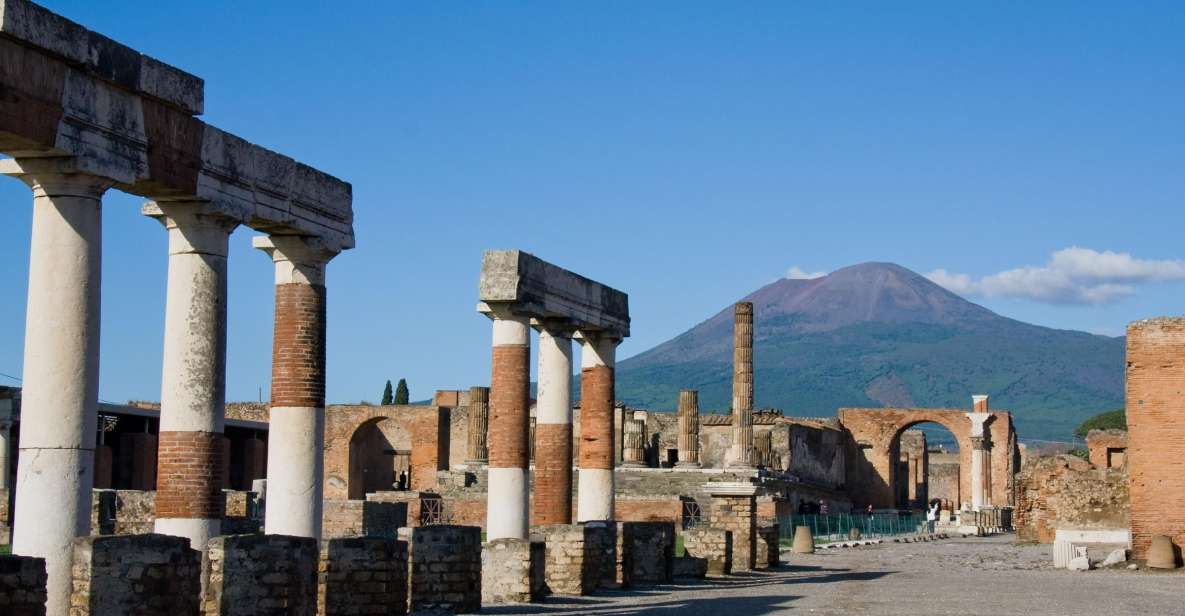
Visitors entering Pompeii through the well-preserved Porta Marina city gate are transported back in time, glimpsing the ancient town’s striking architecture and rich history.
This grand entryway, which dates back to the 2nd century BC, still bears the marks of its former grandeur. Towering columns and detailed carvings adorn the structure, hinting at the impressive scale and artistry of ancient Pompeii.
As travelers pass through the gate, they can almost imagine the bustling crowds that would have streamed in and out daily, going about their business in the thriving Roman city.
The Porta Marina offers a powerful first impression, setting the stage for the incredible exploration of Pompeii’s remarkably well-preserved ruins.
The Forum
At the heart of Pompeii’s ancient Roman town lies the sprawling Forum, a central public square that served as the bustling commercial and administrative center of the city.
This expansive plaza was lined with impressive temples, government buildings, and markets, including the Temple of Apollo, the Temple of the Emperor, and the Macellum indoor marketplace.
Visitors can still see the well-preserved remains of these structures, which offer a glimpse into the daily life and activities that once took place in the Forum.
From conducting business transactions to participating in civic affairs, the Forum was the beating heart of Pompeii, a testament to the vibrant culture and sophisticated urban planning of the ancient Roman world.
More Great Tours NearbyHuman Casts
Among the most poignant sights within Pompeii’s ruins are the haunting human casts – preservation of the final moments of those who perished in the catastrophic volcanic eruption of 79 AD.
These casts, created by pouring plaster into the voids left by decomposed bodies, offer a chilling glimpse into the last seconds of the victims’ lives.
The poses captured include:
- A man crouched in agony, perhaps struggling to breathe.
- A woman shielding a child, an instinctive maternal gesture.
- Two figures embracing, finding solace in each other’s arms.
- Individuals curled up, succumbing to the ash and poisonous gases.
These haunting remnants serve as a somber reminder of the human tragedy that unfolded in Pompeii, forever frozen in time.
You can also read our reviews of more private tours in Pompei
- Pasta Experience in Gragnano and Pompeii Private Tour
- From Napoli: Private Luxury Tour Pompei ,Winery
- Naples: Pompeii Private Guided Hiking Tour
- Pompei & Vesuvius Private Day With Stop Lunch in the Winery
- Pompeii, Herculaneum and Sorrento Private Day Tour From Rome
- Pompeii W/Tickets Sorrento Limoncello Tasting – Private Tour
Bakeries
During the excavations of Pompeii, archaeologists frequently uncovered carbonized loaves of bread that had been preserved in the city’s ancient bakeries, offering a unique glimpse into the everyday lives of the city’s residents.
These carbonized remains provide valuable insights into the types of bread that were consumed in Pompeii, as well as the methods used to bake them.
The discovery of these breads has allowed researchers to better understand the culinary traditions and dietary habits of the ancient Roman city.
The well-preserved bakeries also offer clues about the commercial and social aspects of Pompeii’s economy, shedding light on the importance of bread-making in the daily lives of the city’s inhabitants.
Red Light District
Along With the well-preserved bakeries, Pompeii’s ancient Red Light District offers a unique glimpse into the city’s more salacious aspects, as evidenced by the numerous frescoes of erotic images that have been uncovered by archaeologists.
These frescoes depict a range of sexual acts and imagery, providing a rare window into the private and intimate lives of Pompeii’s residents. The district was likely a hub of commercial sex work and other related activities.
Visitors can explore this notorious area and see the following:
- Explicit wall paintings
- Erotic sculptures and artwork
- Brothel rooms and facilities
- Remnants of sex-related establishments
This controversial yet fascinating aspect of Pompeii’s history offers a revealing look at the ancient Roman city’s complex social and cultural fabric.
Theaters
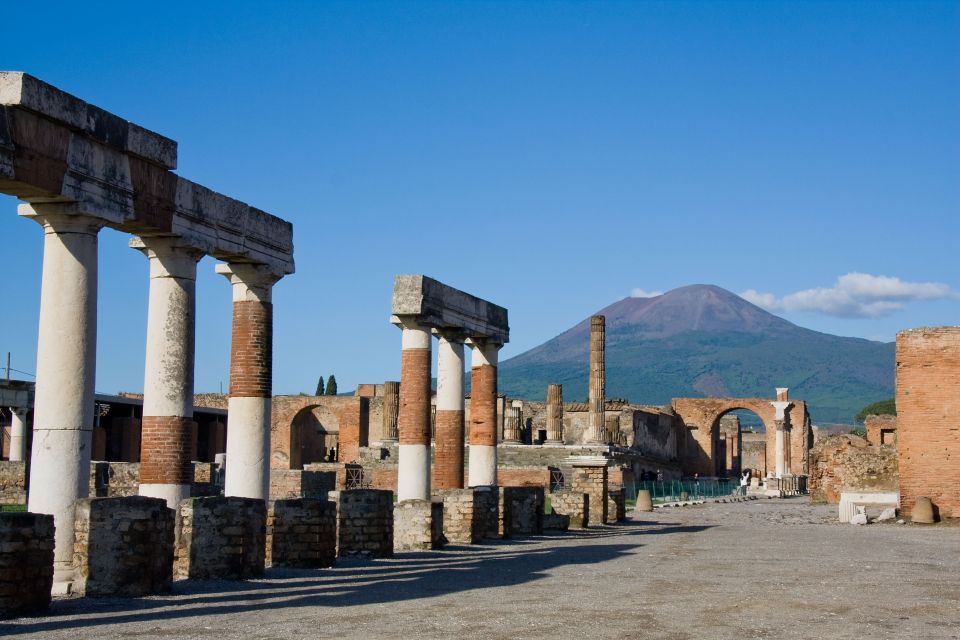
Pompeii’s theaters were prominent centers of entertainment and cultural expression in the ancient Roman city.
The outdoor arena, with its tiered seating, was used for large-scale spectacles, including animal hunts and executions.
The indoor theater provided a more intimate setting for dramatic performances.
The outdoor theater allowed for open-air plays and concerts.
These three distinct venues catered to the varied tastes and preferences of Pompeii’s vibrant community, showcasing the city’s rich cultural heritage before it was ultimately buried by the eruption of Mount Vesuvius.
Frequently Asked Questions
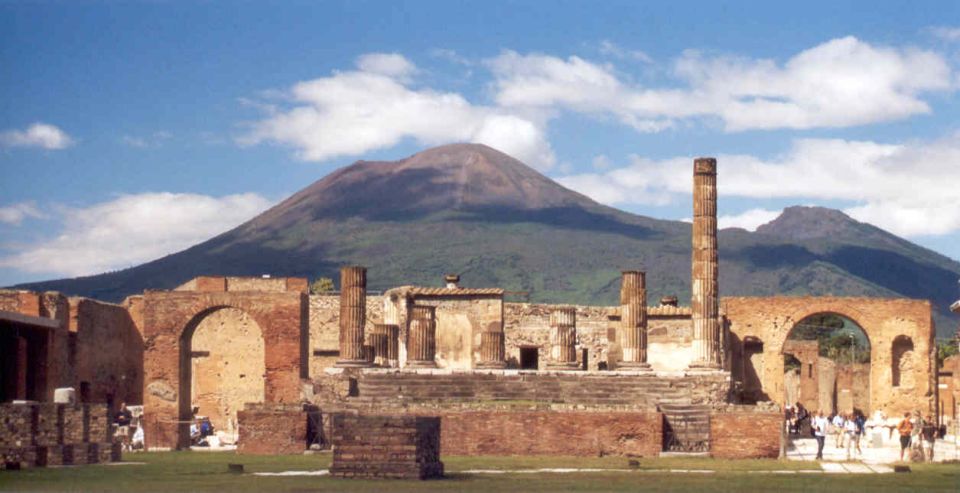
Is There an Option for a Private Tour Guide?
Yes, the tour offers a private walking tour of the Pompeii ruins. The tour is tailored to the interests and abilities of the group, with a private guide leading the exploration of the ancient Roman town.
Can We Bring Children on the Tour?
Yes, children are welcome on the private Pompeii walking tour. The tour can be tailored to accommodate families and provide an engaging educational experience for children to explore the ancient Roman ruins.
Is the Tour Wheelchair Accessible?
The tour is partially wheelchair accessible, with some areas of the ancient ruins requiring visitors to navigate stairs or uneven terrain. Guests with mobility concerns should inquire about accessibility options when booking to ensure the tour meets their needs.
Can We Stop for a Break During the Tour?
Yes, most private walking tours allow participants to take breaks as needed. The tour guide will typically accommodate requests for stops to rest, use the restroom, or explore areas of particular interest at a leisurely pace.
Are There Any Restrictions on Photography?
Photography is generally allowed throughout the Pompeii ruins, though visitors should be respectful and avoid disrupting the experience for others. Some areas may have restrictions, so it’s best to check with the tour guide before taking photos.
Recap
Pompeii’s captivating history and well-preserved ruins offer a unique glimpse into the daily life of an ancient Roman city.
This private walking tour allows you to explore the city’s iconic landmarks, from the bustling forum to the haunting human casts, at your own pace.
With the guidance of skilled local experts, you’ll uncover the fascinating tales and traditions that bring Pompeii’s past to life.
You can check availability for your dates here:More Walking Tours in Pompei
More Tours in Pompei
More Tour Reviews in Pompei
Not for you? Here's more nearby things to do in Pompei we have reviewed
- 25 Best Tours In Pompei
- 25 Best Guided Tours In Pompei
- 3 Best Shore Excursions In Pompei
- 2 Best National Park Tours In Pompei
- 20 Best Wine Tours In Pompei
- 8 Best Cooking Classes In Pompei
- 20 Best Lunch Experiences In Pompei
- 15 Best Walking Tours In Pompei
- 2 Best Dining Experiences In Pompei
- 20 Best Private Drivers In Pompei
- 9 Best Workshops And Classes In Pompei
- 11 Best 2 Hour Tours and Experiences in Pompei
